Roe v. Wade: The Decision That Leaglized Women's Abortion Right
By Avrita Brar
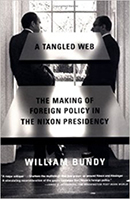
Marian G. Faux
Marian G. Faux is 69 years old and lives in New York City. She has a B.A. in Political Science, English, and Art from Purdue University. Faux is an author of many works, an adjunct professor at the Fashion Institute of Technology, and a senior editor at Henry Regnery Publishing Co. Faux is currently working on a book, A Wild Civility.

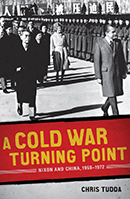


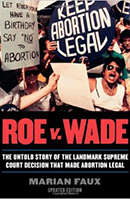
“On the simplest level, this is a story about how two young, inexperienced women, barely out of law school, without any thought of a larger story, decided to test the constitutionality of the abortion law in Texas.”1 Roe v. Wade: the Untold Story of the Landmark Supreme Court Decision That Made Abortion Legal by Marian Faux centers on the ground-breaking Supreme Court Case. It’s a story about a court case that ruled a past state law unconstitutional, which had banned abortions except to save the mother’s life. The states were forbidden from outlawing or regulating any aspect of abortion performed during the first trimester of pregnancy. However, the states could enact abortion regulations related to maternal health in the second and third trimesters as well as laws protecting the life of the fetus only in the third trimester. Within the framework of this Supreme Court Case, this book deals with larger issues—the discriminatory nature of restrictive abortion laws, the inequality women suffer when they cannot control their own bodies, the right of the state versus the federal government to regulate its citizens, and most importantly, the right of privacy.
The book opens with Linda Coffee and Norma McCorvey waiting for Sarah Weddington to arrive at Colombo’s Pizza. Coffee and Weddington had just recently been contacted by McCorvey through another law associate, and they were meeting with their client to see what they could do for her. McCorvey begins to tell her story. A few months ago, she was raped on her way back from a carnival in Augusta, Georgia. When she returned to Dallas, McCorvey went on a search for an abortionist. “She knew that she did not want the child. She did not know the father. She had no way to support a child—no home and little income…Her life was a mess and she had no idea when or how she would pull it together.”2 In 1969, abortion was illegal in Texas, and McCorvey had no luck persuading her doctor to perform an illegal abortion. Linda Coffee and Sarah Weddington were two lawyers who wanted to help women in McCorveys’s position. Interestingly enough, abortion had not touched Coffee or Weddington in a personal way. Yet, like many women, they were frustrated with the current abortion laws. Since the two women had legal skills, they felt they could do something about the present restrictive laws. Although they wanted McCorvey to be their plaintiff, they weren’t so sure after hearing about her unstable background. Her life so far—dropping out of high school, getting married at sixteen, giving birth to a daughter she ultimately did not have custody of, walking out on a visit with her daughter to join a carnival—was a huge problem. However, McCorvey was approaching delivery time, and, by the court ruling, it would be too late to have an abortion. She had to deliver the baby. Offering protection to their new plaintiff, Coffee and Weddington gave Norma McCorvey a pseudonym, Jane Roe.
Coffee and Weddington decided to build their constitutional grounds on the Griswold v. Connecticut case, a challenge to a one-hundred-year-old Connecticut law that forbade the sale of birth control devices. The two lawyers were planning on using “the right of privacy” in their case, something that Griswold v. Connecticut focused on. Coffee and Weddington planned to use the Fourth Amendment, which protected citizens from unreasonable search and seizure; the Fifth Amendment, which protected citizens from self-incrimination; the Eighth Amendment, which forbade cruel and unusual punishment; and the Ninth Amendment, which reserved to the states all powers not specifically granted to the federal government. Fortunately, Coffee and Weddington’s case fell under the jurisdiction of the progressive Fifth Circuit, a bench receptive to civil rights cases. Now that everything seemed to be running smoothly and Norma McCorvey was set as a plaintiff, Coffee wondered if she still needed John and Mary Doe, a young couple who had volunteered to be her plaintiffs a couple months earlier. “Weddington thought the Does’ case was weak, because Mary Doe was not pregnant, but Coffee wanted to keep them and file two separate suits…”3 On Tuesday, March 3, 1970, Coffee filed pleadings on two separate suits, Roe v. Wade and Does v. Wade. District Attorney Henry Wade was being sued by plaintiffs Jane Roe and John and Mary Doe, who were seeking a court order to prevent him from prosecution of future abortion cases. On May 22, 1970, an oral hearing was set and Wade was represented by John Tolle and Jay Floyd, and a month later, the court ruled in favor of the plaintiffs at the state level. However, the Texas legislature still failed to liberalize abortion.
Weddington turned her attention to preparing for the Supreme Court oral arguments, which would take place in mid-December. She and the other lawyers were convinced that the state of Texas would base its defense on fetal rights, as it had in the lower court. “Nellis recalled lengthy discussions on how the Fourteenth Amendment had never contemplated the fetus as a person, how as a result the fetus had never been granted tort rights, inheritance rights, or any other kinds of rights except those contingent on live birth, the point at which the fetus became a legal person.”4 On the day of court at D.C., Weddington talked about “the impact of pregnancy on the women’s lives, describing the discrimination they suffered in jobs and in education when unwanted pregnancies interrupted their lives and the emotional investment required over eighteen years to rear a child.”5 Floyd cited the recent Thompson v. State ruling that had asserted the state’s right to protect the fetus, and claimed that the state’s primary interest was to protect fetal life. “Floyd also cited several examples that demonstrated that marital privacy was not absolute, such as search and seizure laws; laws against fornication and adultery, as well as polygamy; and the fact that parents were required to educate a child.”6 However, when asked about the fact that the Texas abortion law made no exceptions in cases of rape, Floyd answered off the record that a hospital could abort a woman who had been raped. Floyd’s argument hardly ended on a strong note, and for most of the time he was on the defensive. Then, Weddington used her remaining minutes to make a strong rebuttal.
Weddington thought the arguments had gone well overall, although she kept reviewing the questions the justices asked her, each time inventing more persuasive answers. Weddington was admired not only for her intelligence but also for her symbolic and unifying figure within the pro-choice movement. The case was put up for reargument, and Weddington realized she’d be spending her second consecutive summer working on Roe v. Wade. The reargument of the abortion cases took place on October 10, 1972, two and a half years after Roe v. Wade was filed in the lower court. Although the reargument went poorly, Weddington won her election. From her seat in the Texas legislature, she would be able to continue the fight for abortion reform. At the Supreme Court level, Justice Blackmun worked on the abortion issue under Chief Justice Burger. Blackmun had a direction of how to gain support for abortion in the court. He described how the abortion rights could change at various stages of pregnancy. “In the first trimester, the state could not intervene in any way to regulate abortion. In the second trimester, it could intervene only to protect the woman’s health. In the third trimester, or at the approximate point of viability, when the fetus ‘presumably’ has the capability of meaningful life outside the mother’s womb,’ the state could intervene to protect it.”7 The court eventually ruled in favor of the abortion decision under those terms and turned its attention to other decisions.
“Because abortion is an issue that never seems to fade in our collective public consciousness, and because all of us must constantly rethink and reevaluate our position on abortion, I thought it might be helpful to review the relevant issues in their original context as well as to examine them from the distance that time can provide…That is why I wrote this book.”8 Faux believes that abortion is one the most controversial issues of our time and has caused a great deal of pain and rage on both sides of the debate. Abortion concerns nothing less than the value that’s placed on human life. Those who oppose abortion believe that the value must be held as one, that one standard must apply to everyone and all circumstances, while those who support the abortion right believe that the choice lies in the hands of the individual. Faux supports the abortion right, which means she believes “each individual woman must have the right to decide for herself whether to undergo an abortion. It is the only view…that offers any real relief to an otherwise irresoluble dilemma.”9 Faux states that Roe v. Wade carved out a legal rather than moral right, and the process of how this occurred is the subject of her book.
Marian G. Faux has written other works on the subjects of abortion and women, such as Crusaders: Voices from the Abortion Front, which chronicles the recent history of the abortion law debate in aspects of pro-life and pro-choice factions. Faux holds a pro-choice belief, because after interviewing people for her two abortion-based books, she felt the only way this issue could be resolved is if abortion were legalized. “No one is forced to have an abortion; no one is forced not to have one”10 A self-employed writer since 1985, Faux’s areas of expertise include social history, women and children, and women’s work. Published in 1988, Roe v. Wade: the Untold Story of the Landmark Supreme Court Decision That Made Abortion Legal tells the story of the ground-breaking Supreme Court case that was decided in 1973. Although the decision was made, there still remains—even today—opposing sides. Faux states that abortion is the type of issue which will never seem to fade in the public’s conscience.
In Joanna K. Weinberg’s book review of Roe v. Wade: the Untold Story of the Landmark Supreme Court Decision That Made Abortion Legal, she presents an overall high opinion of Faux’s book. “Faux is a journalist, and her book is most valuable as social history…it draws together diverse sources to provide a comprehensive account of the case…ultimately the picture that emerges is one of the most thorough accounts of the case published to date.”11 Although it is filled with behind-the-scenes snippets and equally intriguing legal and social commentary, Weinberg feels that the book contains too much gossip. “Do we need to know that one of the attorneys was a sloppy dresser, or that the other later was divorced?”12 Joan K. Willin’s, lawyer in Hartford, Connecticut, also holds a positive opinion of Faux’s work with a few criticisms. Willin praises Faux for “giving a fascinating account of the Dallas abortion reform movement…revealing such interesting facts as the ACLU’s hesitation to support abortion reform and the tensions between feminists and traditionalists.”13 However, “at times Faux shows a superficial understanding of the legal process and occasionally her discussion of legal theory falters.”14 Both Weinberg and Willin see Faux’s work as a strong piece which entails the necessities of the Roe v. Wade Supreme Court Case, but they are both firm on their individual criticisms of the book.
Roe v. Wade: the Untold Story of the Landmark Supreme Court Decision That Made Abortion Legal is a comprehensive and well written work on the events that led up to the decision, including the important people involved in the case and how much of an impact the decision had on the public. Faux successfully timelines the book and splits it up into four major parts: The Abortion Controversy, In the Lower Court, On Appeal, and Abortion Politics. Faux clearly expresses her pro-choice stance when she discusses the rise of anti-abortion groups. She holds the Catholic Church hierarchy primarily responsible for the anti-abortion movement and claims it used the abortion issue to “round up” straying Catholics. “Abortion began to look like the one issue where the Church could get the right and the left together.”15 Faux is successful in tying ends and sends a clear message to her audience. “That the Roe decision has managed to raise the hackles of both conservatives and liberals is probably to its credit, proof that it is not in any sense a radical decision. Its greatest strength—and ours—is its own centrist position.”16 However, Faux includes unnecessary detail in her work which distracts the reader from the central idea. “Coffee’s skin was the color of richly creamed coffee, and she had dark brown eyes. She wore beiges and browns a lot, which intensified her coloring.”17 Including these details about Linda Coffee do not contribute to her motives in the book or to the meeting she is having with Norma McCorvey. Therefore, the descriptive details are holistically distracting, but Faux is successful in telling the informative, controversial story of Roe v. Wade.
The 1960s were a time inspired by civil rights and anti-war movements in which women began to fight more actively for their rights. The women’s movement took the subject of abortion to the public. A lot of rage, pain, and fear burst out during demonstrations when women openly talked about their illegal abortions. Women marched and rallied for abortion, but reform came gradually. A few states liberalized abortion laws, but ultimately the decision was up to doctors and hospitals. The costs of abortions were high, and few women benefitted. Faux shows that the 1970s were a tumultuous time as well by displaying a part of her book as a continuation of the 1960s. A central example is when Norma McCorvey desires an abortion, but one isn’t legal for a doctor to perform in the state of Texas or many surrounding states. McCorvey attempts to persuade her doctors to perform an illegal abortion, but none of them agree. McCorvey could not “support a child on what she earned, nor could she care for a child…” and this is why she needed an abortion.18 This was the case of many women during the 1960s up till the early 1970s.
Roe v. Wade: the Untold Story of the Landmark Supreme Court Decision That Made Abortion Legal by Marian Faux effectively portrays the story of the significant Supreme Court Case decision with a depth of coverage and insight. “The decision, the legal ruling, in fact leaves the abortion decision where it belongs—in the hearts and minds of individuals and their consciences.”19 Controversial from the moment it was decided, Roe v. Wade politically divided the nation more than any recent case and continues to inspire heated debates, politics, and even a level of violence today.
Footnotes:
1. Faux, Marian. Roe v. Wade: the Untold Story of the Landmark Supreme Court Decision That Made Abortion Legal. New York: Cooper Square Press, 1988. ix.
2. Faux, Marian. 17.
3. Faux, Marian. 84.
4. Faux, Marian. 237.
5. Faux, Marian. 243.
6. Faux, Marian. 250.
7. Faux, Marian. 299.
8. Faux, Marian. xxii.
9. Faux, Marian. xxiii.
10. Faux, Marian. xxiii.
11. Weinberg, Joanna K. “Review: Abortion, Technology and the Law.” JSTOR. Old City Publishing, Inc., n.d. Web. 31 May 2015.
12. Weinberg, Joanna K. “Review: Abortion, Technology and the Law.” JSTOR. Old City Publishing, Inc., n.d. Web. 31 May 2015.
13. Willin, Joan K. “Review: “Anatomy of a Decision”: The “Roe v. Wade” Story.” JSTOR. American Bar Association, n.d. Web. 31 May 2015.
14. Willin, Joan K. “Review: “Anatomy of a Decision”: The “Roe v. Wade” Story.” JSTOR. American Bar Association, n.d. Web. 31 May 2015.
15. Faux, Marian. 185.
16. Faux, Marian. 326.
17. Faux, Marian. 3.
18. Faux, Marian. 16.
19. Faux, Marian. xxiii.
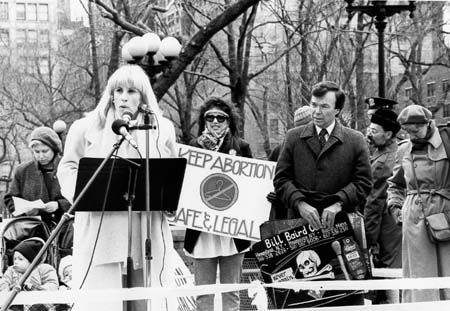

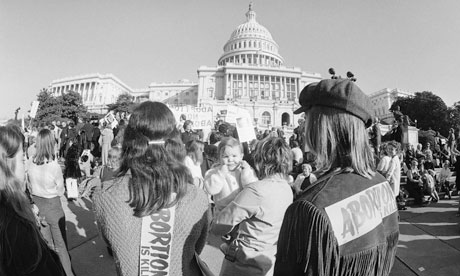
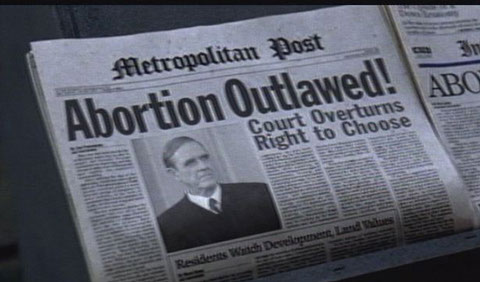
4 - 4
<
>